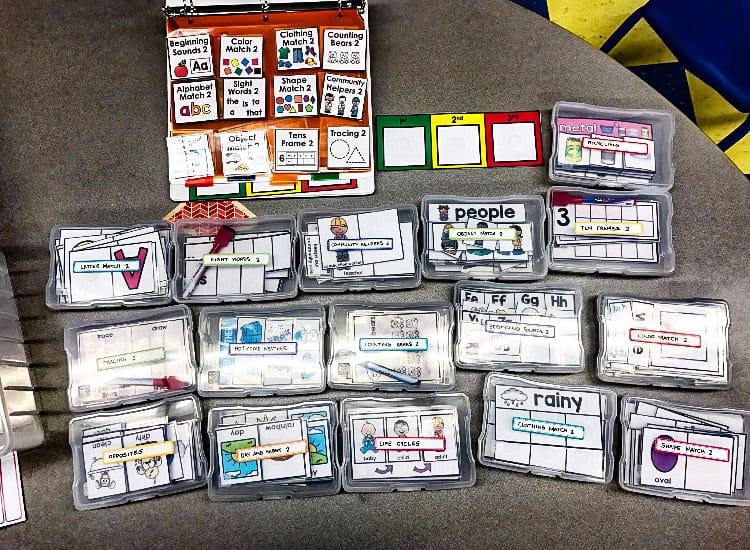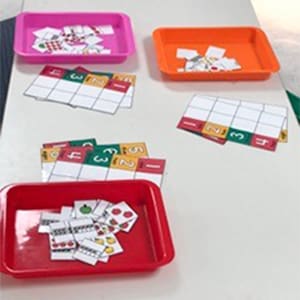Task boxes are one of the strategies and tools we use in Made For Me Literacy to enhance learning for students with diverse needs. If you haven’t used task boxes before, or if you need a refresher, here’s our run down of the who, what, why, where, when, and “WOW!” of these fabulous tools.
What are Task Boxes?

Task boxes are a fantastic resource for educators in a special education classroom. They consist of individual activities or tasks that offer structured learning opportunities for students to develop and practice specific skills. These boxes typically contain various materials like puzzles, flashcards, matching games, and manipulatives tailored to suit students’ individualized needs and abilities.
Types of Task Box
Task boxes are carefully curated to meet the individual needs and goals of students with diverse abilities. Depending on the resources and technology available, they can be physical, digital, or a combination of both.
Physical task boxes
Physical task boxes can be created using storage containers with clearly labeled compartments. Materials can range from manipulatives, flashcards, puzzles, or any other sensory or tactile resources appropriate for the targeted skill areas.
Digital task box apps and websites
Technology can greatly enhance task box activities in special education classrooms. There are numerous digital apps and websites that offer customizable and interactive task box options. These include platforms like Boom Learning, Task Box Fill, or Seesaw, which allow for engaging virtual activities and progress tracking.
Picture-based schedules and visual supports
Visual schedules are an essential part of special education classrooms. Using visual supports like picture schedules or visual task cards within the task boxes can provide clear step-by-step instructions for students to follow independently.
Why are Task Boxes Important in a Special Education Classroom?

Promoting Independence and Autonomy
One of the primary goals of special education is to foster independence and self-reliance.
Task boxes promote independence and autonomy among students with special needs. By engaging in these self-directed activities, students can independently work through tasks at their own pace and with minimal guidance from teachers, support staff, or parents.
This promotes confidence, decision-making skills, and a sense of accomplishment as students complete tasks successfully. In addition, this autonomy boosts confidence and empowers students to take ownership of their learning journey.
Visual supports
Visual supports are essential for many students with special needs, as they enhance comprehension and facilitate communication. Task boxes can be designed with visual aids, such as picture schedules, visual step-by-step instructions, or symbol-supported activities. These visual prompts help students understand tasks, follow directions, and complete activities effectively.
Targeted Skill Development

Task boxes are designed to target specific skills that students need to develop. These can range from fine motor and gross motor skills to cognitive, communication, and social skills. By practicing these skills repeatedly in a structured and engaging manner, students can strengthen their abilities and work towards achieving their individual goals.
Differentiated Instruction

In our special education classrooms, students have diverse abilities and learning styles. Task boxes offer a way to deliver instruction in a differentiated manner, catering to the unique needs of each student. We can create task boxes that are tailored to meet the individualized goals and objectives of our students, and this ensures meaningful and relevant learning opportunities.
Engagement and Motivation
Task boxes are designed to be visually appealing and engaging for students. With colorful materials, interactive elements, and hands-on activities, these boxes capture students’ attention and maintain their interest throughout the learning process. This enhanced engagement leads to increased motivation, active participation, and a positive attitude towards learning.
Progress Monitoring and Data Collection
Task boxes serve as valuable tools for progress monitoring and data collection in a special education classroom. Teachers can observe and document students’ performance, noting areas of strength and areas that require additional support. This data helps in making informed instructional decisions, modifying or adapting tasks to better meet students’ needs, and tracking progress over time.
Generalization of Skills
Task boxes provide opportunities for students to generalize skills learned in the classroom to real-life situations. For example, a task box activity that involves sorting objects by color can be extended to sorting items in a grocery store or organizing items at home. This promotes the transfer of skills and helps students apply what they have learned in meaningful contexts.
How to Successfully Implement Task Boxes

Identify Individual Goals and Objectives
Before implementing task boxes, it is crucial to identify each student’s goals and objectives. By aligning task box activities with specific learning targets, teachers can ensure that students are engaging in meaningful and purposeful practice.
Create an Organized System
Establish a well-organized system for storing and accessing task boxes. Label each box with clear instructions and expectations, ensuring that students can easily understand and navigate through the activities independently.
Introduce and Model
Take the time to introduce each task box activity to students, providing clear instructions and modeling the expected behaviors. This initial guidance and support will help students understand the purpose of each task and how to engage with the materials effectively.
Implement a Rotation System
Implement a rotation system where task boxes are regularly changed or updated. Such a system will help to avoid monotony and provide variety. This, in turn, keeps students engaged and interested, preventing boredom or disengagement.
Monitor and Provide Feedback
Regularly monitor students’ progress as they engage with task boxes. Provide feedback and positive reinforcement to acknowledge their efforts and achievements. This helps to build students’ self-confidence and motivation.
The Last Word
Task boxes play a vital role in our special education classrooms, offering a range of benefits for students with diverse needs. From promoting independence and autonomy to targeting specific skills, these structured learning opportunities enhance engagement, facilitate progress monitoring, and support differentiated instruction.
By effectively implementing task boxes, we can create an inclusive and empowering environment that fosters our students’ overall development and growth.
Anonymous says
I love task boxes and use many of yours! Another great thing about them is when I have an adult up in your room & I am supposed to utilize them in some way, if they aren’t great with the students, I always have a pile of in progress task boxes for them to work on!